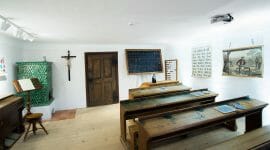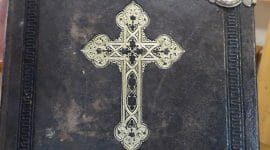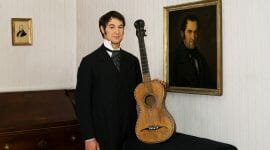
Childhood and school years in Upper Austria
Conrad Xaver Gruber was born on 25 November 1787 into poor circumstances: He grew up in the house that he was born in at Unterweizburg 9 in the Hochburg municipality in the Innviertel region, living with his parents Josef and Anna, as well as their first four children. Little Conrad was the fifth. A sixth was planned. Only in 1779, the region became part of “Land ob der Enns”, and thus of Austria, as a result of the War of the Bavarian Succession. The economic situation was dire and small farmers earned an additional income from weaving. Franz Xaver Gruber — who, as was common at the time, took on his godfather’s first name — had to learn his father’s craft initially. However, even as a child, he loved music over anything else.
The boy was born with a talent for music
Gruber’s school teacher Andreas Peterlechner promoted his talents and gave him free music lessons, which his father was vehemently opposed to. After several years of secretive organist practice, Franz received his first own instrument at the age of 11. Beginning 1805, he was also able to begin his training as a teacher that he had been longing for. First, the young man perfected his musical abilities with the parish organist Georg Hartdobler in Burghausen, who — on the other side of the Salzach river — lived on Bavarian territory, and thus in a foreign country. These years were overshadowed by the Napoleonic wars — a dangerous time, with the occupiers right at the doorstep. Gruber completed his training as a teacher in Ried in the Innkreis region and took his exams there in 1806. Gruber completed the mandated year of work experience as a school assistant to his supporter and teacher Peterlechner in Hochburg.
Teacher, sacristan and organist in Arnsdorf and Oberndorf
In 1807, the 20-year-old Franz Xaver Gruber began his first independent position as a teacher, sacristan and organist in Arnsdorf. However, not without having to repeat all of his exams once more in Salzburg, where different rules applied. In the same year, he married his predecessor’s widow, Maria Elisabeth Engelsberger, who was 13 years older — a condition requested by the community and quite common at the time, which allowed him to move into the sacristan’s residence. Gruber had two children with her; both died prematurely. In order to improve his financial situation and in the hope to one day receive the teaching position in Oberndorf, he also worked as a choirmaster and organist at the St. Nikola Church, located just four kilometres away in Oberndorf, beginning in 1816.
A melody for the Christmas mass of 1818
Gruber was considered an excellent teacher, his great passion, however, was music, which had given him so much consolation in the more difficult times of his life: Of Gruber’s twelve children, only four grew up to become adults, two of his wives passed away. Beginning in 1817, his love for music connected him with the new assistant priest in Oberndorf, Joseph Mohr, a passionate singer and guitar player. On Christmas 1818, Gruber added a melody to Mohr’s six-stanza poem “Silent Night” that Joseph Mohr had given him. The priest and the teacher sang it together after the Christmas mass at the St. Nikola Church in Oberndorf, Mohr accompanied the performance with his guitar. After this first act, Gruber composed an additional organ arrangement for the song. Other than that, however, the song didn’t seem to hold any particular significance for him. He described it as “a simple composition”.
Musical high points in Arnsdorf
The high point of Gruber’s career in Arnsdorf was the 300-year anniversary of the “Maria im Mösl” pilgrimage church in 1820. The festival lasted for five days and counted 20,000 visitors. High-ranking guests, such as abbots from the Michaelbeuern Abbey and St. Peter’s Abbey, Salzburg, attended the concerts by the orchestra that Gruber was conducting.
After the death of his first wife in 1825, he married his former pupil Maria Breitfuß. The marriage resulted in ten children; only four of them survived to become adults: Franz Xaver, Elisabeth, Amalie and Felix. Gruber did not manage to get transferred to Oberndorf. There were also several disagreements with his superiors. In 1829, he transferred to Berndorf near Salzburg to work as a teacher and sacristan, a municipality which valued good church music.
A life for music in Hallein
Gruber’s most ardent wish, to be able to focus more on his music, came true in 1835, when he was named choirmaster, lead singer and organist for the parish church of Hallein. At the time, Hallein was the province’s second largest town and counted around 3,500 inhabitants. Filled with enthusiasm, Gruber dedicated himself to training singers and musicians for the church choir. He composed and participated in many musical events, also outside of Hallein. In 1841, Gruber’s second wife died. One year later, Gruber married his third wife, his second wife’s friend, the shoemaker’s widow Katharina Rieser (widowed Wimmer) from Böckstein. Gruber’s sons from his second marriage stepped into the musical footsteps of their father: The oldest, Franz (1826 – 1871), founded a choir group in 1847, as well as the Halleiner Liedertafel musical group in 1849, which still exists today. His second son, Felix (1840 – 1884), followed his father to become the choirmaster of Hallein. Franz Xaver Gruber died of old age in 1863 in Hallein.
A friendship which lasted for a lifetime
After their shared years in Oberndorf, the author and the composer of “Silent Night” remained connected through their friendship for years: Joseph Mohr visited his friend several times in Hallein. In contrast with Mohr, who already died in 1848, Gruber still got to experience the song’s first wave of success in Germany. In 1854, he authored a document to clear up several misconceptions about its origins: namely, that the song had not been composed by Michael Haydn and that the Christmas song did not originate from the Zillertal valley in Tirol but from Oberndorf in SalzburgerLand.






